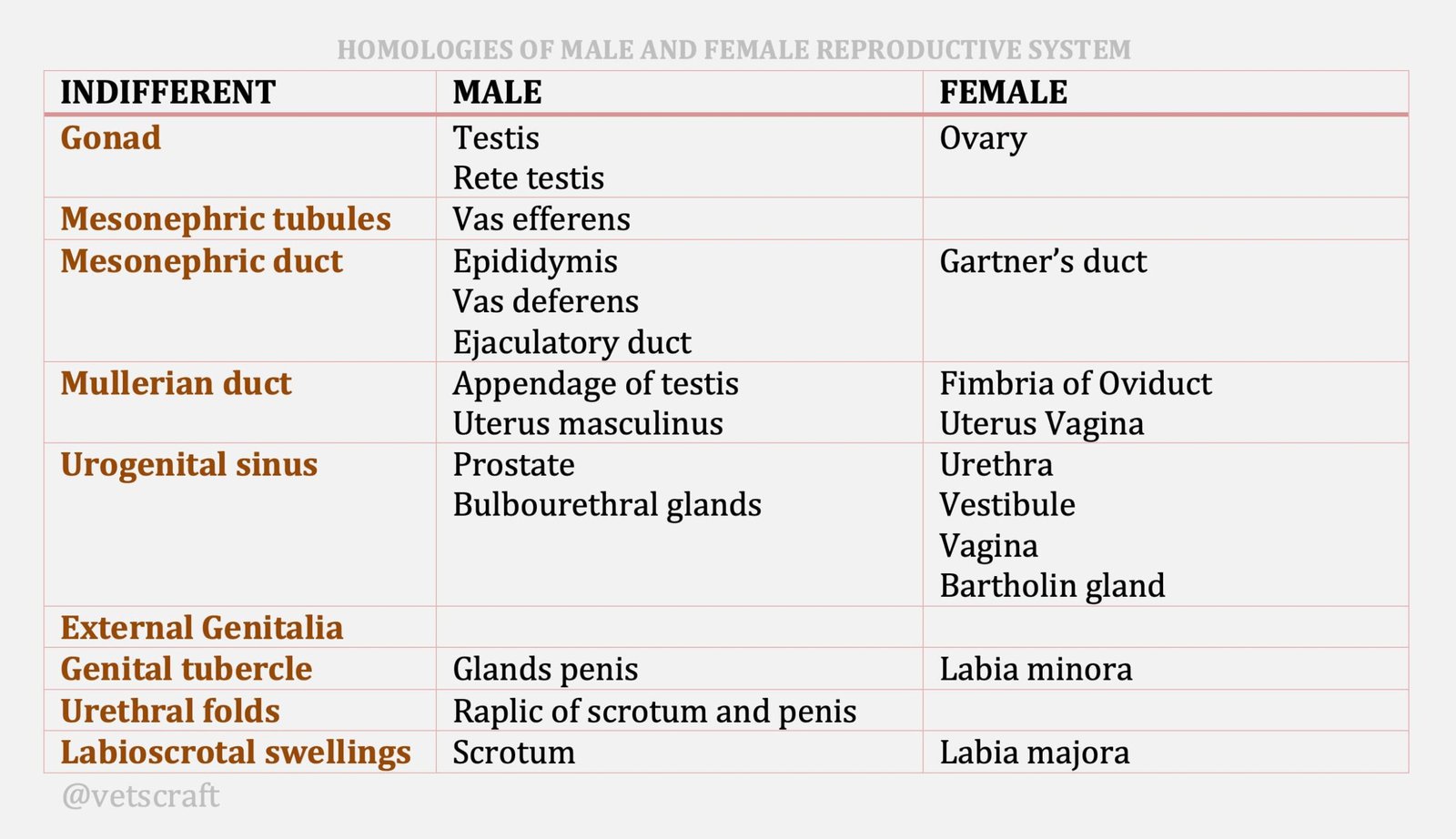TABLE OF CONTENTS
Ovaries of Animals
Ovaries of these animals will be discussed in this post:
- Cattle
- Mare (Female horse)
- Ewe (Female sheep)
- Sow (Female pig)
- Bitch (Female dog)
- Cat

Ovaries of Cattle
Ovaries are paired organs located one on each side of the uterus in proposition to the lateral wall of the pelvis.
They are usually oval or almond in shape between 1.3 cm in length, 1.3 to 3.2 cm width and 0.6 to 1.9 cm thick and weighs about 5 to 15 gms. The anterior (cranial) portion of the broad ligament attached to and supports the ovary and is called the mesovarium.
The mesovarium carries the blood and the lymohatic vessels and nerves which supplies the ovary and forms the hilus of the ovary. The second supportive ligament, the utero ovarian ligament attaches the ovary to the uterus.
The free surface of the ovary is physiologically active where follicles and corpus luteum develop. The mesovarian and uterovarian ligament form a bursa like pouch called the ovarian bursa or ventricle.
The ovary is covered by the outer most single layer of cuboidal cells called the germinal epithelium. This layer has no function relating to production of the germinal cells and is thus erroneously named.
Beneath the germinal epithelium is the tunica albugunia, a connective tissue composed of fewer cells and closely packed fibers. Beneath the tunica albugunia,is the ovarian cortex, which contains the follicles and corpus luteum in various stages of development or regression.
Many fibroblast, some collagen and reticular fibres, blood vessels, nerves, lymphatic vessels and smooth muscle fibers form the connective tissue of the ovarian cortex. The central part of the ovary is called the ovarian medulla. The medulla houses the vasculature, nerves and the lymphatic‘s and is composed of dense connective tissue.
Schematic illustration of the ovary the primary structures and their sequence of development. It should be that, in general all types of follicles are present within the ovary at any point in time.
However, developing and the corpus lutea may or may not be present depending on the stage of the estrous cycle with the exception of the mare. Development (and regression) of all ovarian structures occurs at random locations within the ovary.
A primary follicle is a germ cell surrounded by a single layer of follicular cells. They are located in the parenchyma and seen in groups called egg nests.
Secondary follicles is a potential ovum surrounded by two or more layers of follicular cells.
Tertiary Follicle: Development of an antrum (cavity) formed by collection of fluid between the follicular cells separating them. Antrum filled with liquor folliculi and rich is estrogen. The mature tertiary follicle which appears as a fluid filled blister on the surface of the ovary is called the Graafian follicle.
In the Graafian follicle, the outer most fibrous cell layer is the theca externa. Inside this layer is the theca interna. Both cell layers are supplied with blood by capillary network. Basement membrane separates theca interna from the granulose cells and prevents entry of the vascular system into these cells. The granulose cells surround the antrum containing liquor folliculi. The cumulus oophorus is located at one side of the antrum. The potential ovum rests upon the discus proligenous.
Granulose cells surrounding and in immediate contact with the ovum are called corona radiate. Both the theca cells and granulose cells are involved in production of estrogen.
Ovaries of Mare
The ovaries are bean shaped and they are 4 to 8 cm in length, 3 to 6 cm in width and 3 to 5 cm in thickness, weighing 30 to 90 gms. The right ovary is more active and larger than the left. Ovulation in the mare occurs at the ovulation fossa while it occurs at random locations in the ovary of cow, ewe and sow. The follicles can be located per rectum in the mare but the corpus luteum cannot be palpated as they do it protrude from the ovarian surface and penetrate into the ovarian tissue and its use of thick tunica albugenia. The diameter of the corpus luteum is also smaller than that of the mature Graafian follicle and is cauliflower in shape.
Ovaries of Ewe
The ovaries are almond shaped and about 1.3 -1.9 cm in length resembling these in cow.
Ovaries of Sow
Ovaries are oval in shape and are concealed in the bursa by the mesosalpinx. The ovaries may be mulberry in appearance in the multiple follicles or corpora lutea.
Ovaries of Bitch
Ovaries are oval in shape located beneath the 3rd and 4th lumbar vertebrae. The ovaries concealed in the bursa ovarii and it contains fat.
Ovaries of Cat
The ovaries similar to dog, suspended more ventrally in the abdominal cavity and the ovarian bursa contains no fat.
Functions of the Ovary of Animals
The primary function of the ovary is to produce the female gemete the ova and the hormones, estrogen and progesterone. The ovary also produces oxytocin, relaxin, inhibin and activin.
Oxytocin is also produced by corpus luteum besides the posterior pituitary causes contraction of smooth muscle and regulates luteolysis.
Relaxin is a polypeptide hormone secreted by the placenta and/or in the large luteal cells of corpus luteum of pregnancy that causes the cervix to dilate and softens the ligaments in the pelvic region, thus tending to widen the birth canal during parturition.
Inhibin is a glycoprotein produced by the granulosal cells in the female that specifically inhibits the release of FSH from the anterior pituitary.
Activin is a protein from follicular fluid that consists of two β submits and are ovum to cause release of FSH in pituitary cells in culture. It therefore causes the opposite of inhibin in vitro. This function has not been demonstrated in the intact canal and thus, it is not as yet considered a hormone.
Structure of the Ovary of Animals
Structure of the ovary of animals will be covered in anatomy section.

